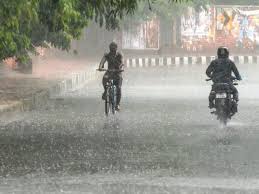In the face of a danger drought crisis holds Karnataka, an unexpected twist of weather has recently emerged, offering a glimmer of hope amidst the prevailing parched conditions. Several districts in the state have experienced heavy rainfall and lightning, a phenomenon that has caught many by surprise. According to data from the Karnataka State Natural Disaster Monitoring Centre (KSNDMC), active North East Monsoon conditions have been observed in Coastal, Malnad, and South Interior Karnataka districts. However, the monsoon activity remains weak in the North Interior Karnataka districts, as indicated by the 24-hour data ending at 8:30 am on November 6.
The extraordinary moment between this weather irregularity was the remarkable rainfall recorded in Chennaithodi, situated in Bantwal Taluk, Dakshina Kannada District, where an unusual 150.5 mm of rainfall was observed. The weather forecast further predicts scattered to common light to moderate rains, with outlaying heavy rainfall, likely over parts of Coastal, Malnad, and interior districts of the state until the morning of November 7.
Analysing the latest rainfall data from TRG Stations across the state for the last 48 hours, it is evident that common rains have washed six districts, namely Dakshina Kannada, Udupi, Hassan, Shivamogga, Davanagere, and Chikkamagaluru. Additionally, fairly common rains were reported in Chitradurga, Bengaluru Rural, Chikkaballapura, and Chamarajanagara. Nine districts, including Uttara Kannada, Kodagu, Tumakuru, Haveri, Vijayanagara, Kolar, Mysuru, Mandya, and Ballari, experienced scattered rains, bringing some relief to the drought-stricken regions. However, unusual rains were observed in Raichur, Bengaluru Urban, Koppala, and Ramanagara. Unfortunately, eight districts, namely Gadag, Bidar, Kalaburagi, Bagalkote, Dharwad, Belagavi, Yadgir, and Vijayapura, had to contend with dry or slightly rainfall during this period.
To check these recent weather events, the increasing rainfall data collected by the KSNDMC from October 1 to November 5 is vital. In South Interior Karnataka, where the normal rainfall is 152 mm, the actual recorded rainfall stood at a mere 61 mm. The situation is even more shocking in North Interior Karnataka, with the normal rainfall recorded at 113 mm and the actual rainfall being only 12 mm. The Malnad region, which typically enjoys 172 mm of rainfall, received a partly 103 mm, highlighting the severity of the drought crisis. On the other hand, the coastal districts fared relatively better, receiving 178 mm of rainfall, which is close to their normal average of 201 mm.
This unexpected and mixed rainfall, while temporary, has provided a brief break to the drought-affected regions, underscoring the unpredictable nature of weather patterns. Authorities are closely monitoring the situation as the weather forecasts suggest the continuation of rain activity, offering a temporary relaxation to the dried-up landscapes of Karnataka.

